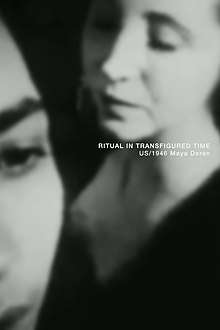Ritual in Transfigured Time
Ritual in Transfigured Time (1946) is a short, silent experimental film directed by Maya Deren.[1] Like Deren's previous work, A Study in Choreography for Camera (1945), she explores the use of dance on film through the lens of commentary of societal norms, metamorphosis, and anthropomorphism. The film is notable for its disjointed storytelling and use of slow motion, freeze framing, and unique blend of stage dance and film.
| Ritual in Transfigured Time | |
|---|---|
 | |
| Directed by | Maya Deren |
| Produced by | Maya Deren |
| Written by | Maya Deren |
| Starring |
|
| Cinematography | Hella Hammid (as Hella Heyman) |
| Edited by |
|
Release date |
|
Running time | 15 minutes |
| Country | United States |
Deren became known for her affinity for dance in other subsequent films such as Meditation on Violence, Ensemble for Somnambulists, and Divine Horsemen: The Living Gods of Haiti. Elinor Cleghorn writes: "While she never undertook formal training, she identified as a dancer; but rather than pursuing a career as a performer she made her fascination with dance as cultural expression the focus of her progression as a writer and researcher."[2]
Plot
Deren's character sits in a room spinning layers of twine in a manner reminiscent of cat's cradle. Dancer #1, played by Christiani, enters the room and begins wrapping up the spool from Deren's hands. Close-up and slow motion highlight intense feeling on Deren's face as she performs the first of the rituals in the film. 'Haughty Woman', played by Nin, looks upon the scene scornfully.
We cut to a new scene where Dancer #1 is wearing a black hooded garment and a cross necklace. A crowded room full of people interact through expressive, dance-like movements. As people try to approach her, she moves to avoid them with graceful, evasive maneuvers. As she goes across the room she looks around intently to find someone. She spots Dancer #2, played by Frank Westbrook, at the back of the room. The two meet and lock eyes.
Dancer #1 breaks away from Dancer #2 as other women flock around him. She walks among granite structures and statues in seeming confusion. She comes upon Dancer #1 posing atop a pedestal as a statue. She approaches and as he moves, she begins to back away. He slowly chases after her in long, slow, hopping strides across a field. Deren's character runs underneath a pier into the ocean as Dancer #2 looks on. She wades further and further into the water before the film cuts to negatives. They depict a woman sinking down into the water past the screen. The last shot of the movie is Dancer #1 lifting a bride's veil above her head.
Analysis
Speaking of her inspiration, Deren wrote: "A ritual is an action distinguished from all others in that it seeks the realization of its purpose through the exercise of form. In this sense ritual is art; and even historically, all art derives from ritual. In ritual, the form is the meaning. More specifically, the quality of movement is not merely a decorative factor; it is the meaning itself of the movement. In this sense, this film is dance."[3]
Furthering Deren's theme on rituals, Moira Sullivan says ritual archetypes in the film are: "juxtaposed with images of modernity and frozen matter - freeze frames, statues, bodies – are ‘spiritualized’ through movement, similarly how symbolist poetry (one of Deren’s poetic influences) ‘spiritualized language’."[4]
Deren's character in relation to Christiani's is almost mirror-like, leading film writer Bruce McPherson to write: "In Ritual in Transfigured Time, Maya appears as the protagonist’s counterpart, at once a double of Christiani and her familiar spirit, in a social choreography that moves towards the accomplishment of the protagonist’s ‘critical metamorphosis.’"[3] This metamorphosis is further contextualized by writer William C. Wees, who says: "...references to water and dance accumulate and gain increasing significance as the film proceeds. Through them a theme of paired opposites becomes apparent. It is suggested by references to Deren's use of positive and negative images: the widow's black gown is transformed (in negative) into a white bridal dress at the end…"[5]
The personal nature of Deren's work, like her other films, is present in Ritual, as it's said some of the themes throughout are direct links to her life, albeit shrouded in her characteristic muddled storytelling. "Deren’s oeuvre is personal to the extent of being almost autobiographical, clearly stemming from her experience of successive marriages and divorces. But she tried to comprehend and transcend that experience by setting it in a context not of resolution and closure, but of contradiction and assimilation (loss and gain, mourning and restitution, death and survival); the widow, drowned, is also a bride, alive, alone."[6]
References
- Haslem, Wendy (12 December 2002). "Great Directors: Maya Deren". Senses of Cinema (23). Retrieved 19 June 2011.
- Cleghorn, Elinor (2016). "'One must at least begin with the body feeling': Dance as filmmaking in Maya Deren's choreocinema". Cinema Comparat/ive Cinema. 4 (8): 36–42.
- Deren, Maya (2005). Essential Deren: Collected Writings on Film. Documentext. ISBN 978-0-929701-65-3.
- Sullivan, Moira. "2 x Maya Deren I. Experimental Films (1943-1959)". Filmint. Filmint. Archived from the original on 2007-08-10. Retrieved 14 November 2018.
- Wees, William Charles (2005). "In the Mirror of Maya Deren (review)". The Moving Image. 5 (1): 136–140. doi:10.1353/mov.2005.0021. JSTOR 41167192.
- "Ritual in Transfigured Time". Monthly Film Bulletin. 55 (654): 217. 1 July 1988. ProQuest 1305838685.